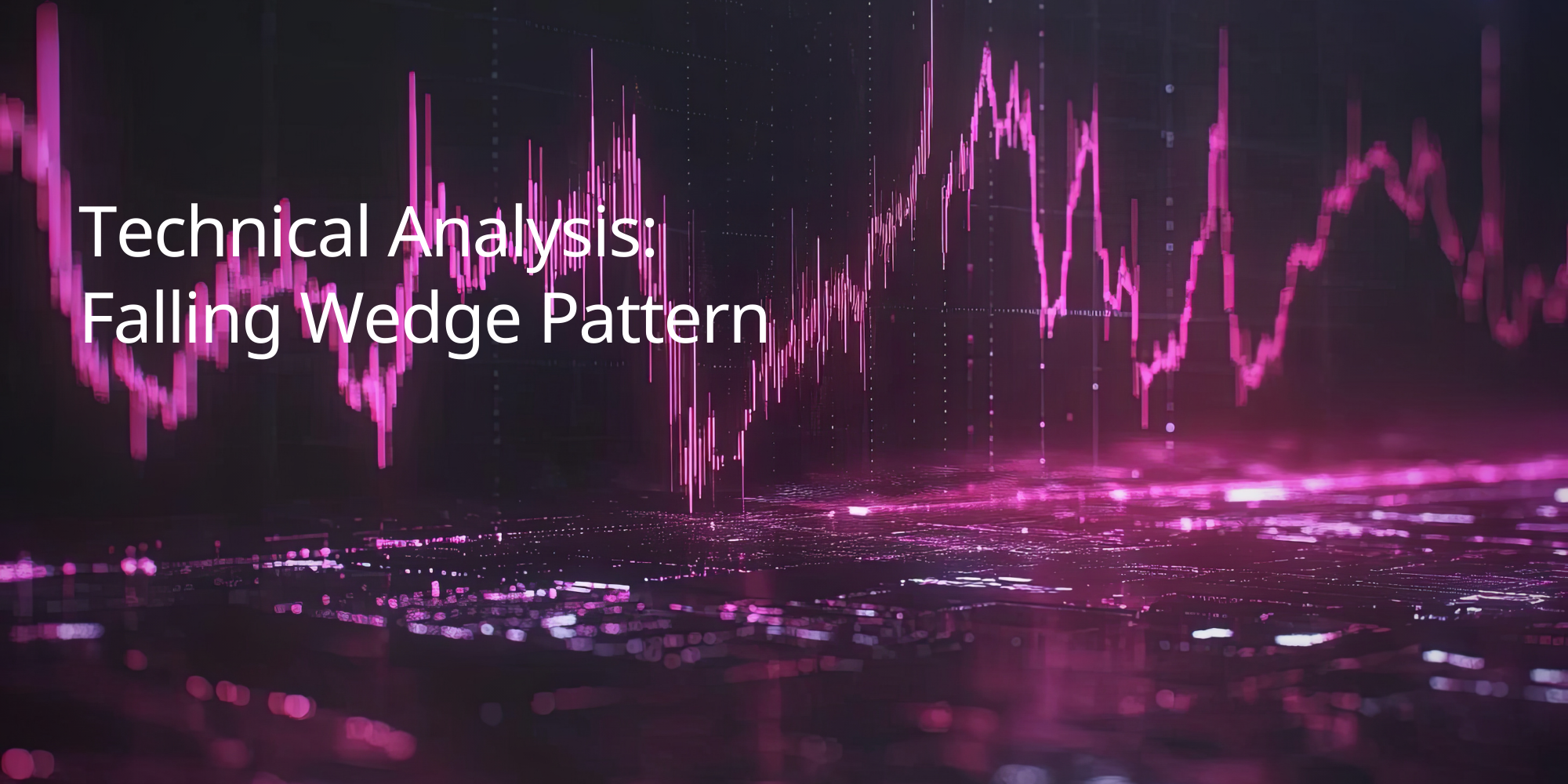Falling Wedge Pattern: A Bullish Reversal Signal
The Falling Wedge is a bullish chart pattern that often signals the end of a downtrend and the beginning of a potential uptrend. Formed by converging trendlines sloping downward, the pattern reflects a period of consolidation before price breaks higher.
In this guide from TradeSmart, we’ll explore:
- The structure and characteristics of the Falling Wedge pattern
- How and when it forms during a market trend
- Entry and exit strategies based on confirmed breakouts
- How to combine it with other indicators for more accurate signals
Whether you're looking to enter at the start of a trend or add confluence to your setup, the Falling Wedge is a reliable tool for bullish reversal trading.
What is the Falling Wedge Pattern?
The Falling Wedge is a bullish reversal pattern that typically forms after a downtrend. It's characterized by two converging downward-sloping trendlines, with the price making lower highs and lower lows, but with the price range narrowing. This suggests that downward momentum is weakening and a reversal to the upside could be imminent.
Key Characteristics:
- Two Downward-Sloping Trendlines: The pattern is formed by two trendlines that are both sloping downwards, but converging towards each other.
- Lower Highs and Lower Lows: The price makes lower highs and lower lows within the pattern, but the distance between the highs and lows is decreasing.
- Increasing Volume: Volume typically increases as the pattern matures, indicating increasing buying pressure.
- Breakout: A breakout above the upper trendline confirms the pattern and signals a potential trend reversal to the upside.
How the Falling Wedge Pattern Works
The Falling Wedge pattern suggests that sellers are losing momentum and buyers are starting to gain control. The narrowing price range indicates that the downtrend is becoming weaker, and a breakout above the upper trendline confirms the reversal and signals a potential new uptrend.
Advantages and Limitations of the Falling Wedge Pattern
The Falling Wedge pattern can be a valuable tool for traders, but it's important to understand both its strengths and weaknesses.
Advantages:
- Frequent Occurrence: The Falling Wedge pattern appears relatively frequently in financial markets, providing traders with ample opportunities to identify and trade it. This also makes it easier to backtest trading strategies based on the pattern using historical data.
- Clear Trading Signals: The Falling Wedge pattern provides clear entry and exit signals. Traders can enter long positions when the price breaks above the upper trendline and set stop-loss orders below the lower trendline.
- Favorable Risk-Reward Ratio: The potential reward for a Falling Wedge trade can often be significantly larger than the potential risk. This is because the pattern typically signals a reversal to an uptrend, potentially leading to substantial price gains.
Limitations:
- Subjectivity in Identification: Identifying Falling Wedge patterns can be subjective, as the trendlines and the breakout point might not always be clear-cut. This can lead to different interpretations and potentially inaccurate trading signals.
- False Signals: Like any technical indicator, the Falling Wedge pattern can generate false signals. The price might break above the upper trendline and then quickly reverse back down, leading to a false breakout and potential losses for traders.
- Not Always a Reversal Signal: While typically considered a bullish reversal pattern, falling wedges can sometimes act as continuation patterns, especially when they form within an uptrend. This can lead to false signals if traders don't consider the broader market context.
Mitigating the Limitations
To overcome these limitations, traders can:
- Combine with Other Indicators: Use the Falling Wedge pattern in conjunction with other technical indicators, such as moving averages, trend lines, or momentum oscillators, to confirm signals and filter out false signals.
- Consider Market Context: Always interpret the pattern's signals in the context of the overall market environment. Consider factors such as news events, economic data releases, and the broader market trend when making trading decisions.
- Practice Risk Management: Use appropriate risk management techniques, such as stop-loss orders and position sizing, to limit potential losses.
TradeSmart encourages traders to use the Falling Wedge pattern as part of a comprehensive trading strategy. By understanding its limitations and combining it with other analytical tools, traders can make more informed decisions and improve their trading outcomes.
Identifying the Falling Wedge Pattern
The Falling Wedge pattern is a bullish reversal pattern that can appear in various markets and timeframes. Here's how to identify it and understand its implications:
Identifying the Pattern
- Determine the Trend: The Falling Wedge can appear in both uptrends and downtrends, but its interpretation differs depending on the context.
- Converging Trendlines: Look for two downward-sloping trendlines that converge as they extend to the right. The upper trendline should be steeper than the lower trendline.
- Narrowing Price Range: The price action within the wedge should be making lower highs and lower lows, but the distance between the highs and lows should be decreasing. This creates the characteristic "wedge" shape.
- Increasing Volume: Ideally, volume should increase as the pattern matures, indicating increasing buying pressure and the potential for a reversal.
- Confirm the Breakout: Look for a decisive breakout above the upper trendline of the wedge. This confirms the pattern and signals a potential reversal to an uptrend (or a continuation of the uptrend if the pattern formed within an uptrend).
Combining the Falling Wedge with Other Indicators
The Falling Wedge pattern can be a powerful tool on its own, but combining it with other indicators can enhance its effectiveness and provide more reliable trading signals.
Here are some indicators that work well with Falling Wedge pattern analysis:
- Momentum Oscillators: Momentum oscillators can help identify overbought and oversold conditions, which can be useful for confirming potential reversals in Falling Wedge patterns. Some popular momentum oscillators include:
- Relative Strength Index (RSI): Look for oversold conditions in a Falling Wedge pattern to confirm a potential bullish reversal.
- Stochastic Oscillator: This oscillator can also be used to identify oversold conditions and potential bullish divergences.
- Trend-Following Indicators: Trend-following indicators can help confirm the direction of a trend after a breakout from a Falling Wedge pattern. Some popular trend-following indicators include:
- Moving Averages: A break above a key moving average can confirm a bullish reversal from a Falling Wedge.
- MACD: A bullish crossover on the MACD can also confirm a bullish reversal.
- Volume: Analyzing volume in conjunction with Falling Wedge patterns can provide further confirmation of the strength of a move. Increasing volume on the breakout from a Falling Wedge suggests strong conviction behind the price movement.
Example:
Imagine a stock that has been in a downtrend. The price starts to form a Falling Wedge pattern, with lower highs and lower lows, but the price range is narrowing. The RSI is showing oversold conditions, and the MACD is forming a bullish crossover. This confluence of signals suggests that the downtrend is likely to reverse after the breakout from the Falling Wedge.
Conclusion
The Falling Wedge pattern is a powerful tool for spotting bullish reversals and entering trades with confidence at the early stages of a trend. By understanding how to identify the pattern and validate its breakout, you can refine your entry points, manage risk, and improve your overall success rate.
TradeSmart gives you everything you need to use the Falling Wedge effectively:
- Spot and confirm Falling Wedge formations on MT4 and MT5 platforms
- Combine with volume, RSI, or MACD for stronger confirmation
- Build breakout strategies that include smart stop-loss and take-profit levels
- Access educational content and real-time market insights
Ready to trade bullish reversals with confidence?
- Open a TradeSmart account today and access our advanced trading platforms
- Practice your Falling Wedge strategy in a risk-free demo account
- Start live trading with just a $50 minimum deposit
Visit TradeSmart.com and unlock the full potential of the Falling Wedge pattern in your trading strategy.





